Last updated: February 28, 2024
Any links on this page that lead to products on Amazon are affiliate links and I earn a commission if you make a purchase. Thanks in advance – I really appreciate it!
Ever wondered why some male horses seem calmer? The secret often lies in gelding, the practice of castrating male horses, which significantly influences their temperament and health. With over 25 years in the horse industry, I’ve seen how gelding transforms a horse, making it more manageable and suited for equestrian activities.
This procedure isn’t just about behavior—it’s a crucial decision for a horse’s role and well-being in competitive racing and sports. Let’s explore the importance of gelding in horse management.

Thoroughbred gelding horse. Source: Lar, CC BY-SA 4.0
What is a Gelding Horse?
Let’s begin with the basics. A gelding horse is a castrated male horse, and gelding is a veterinary procedure that involves the surgical removal of the testicles to reduce testosterone production.
Why Geld Horses?
- Behavior Management:
- Reduces aggression
- It makes horses safer and easier to handle
- Health Benefits:
- Lowers the risk of diseases related to the reproductive system
- Suitability for Activities:
- Ideal for recreational riding and competitive sports
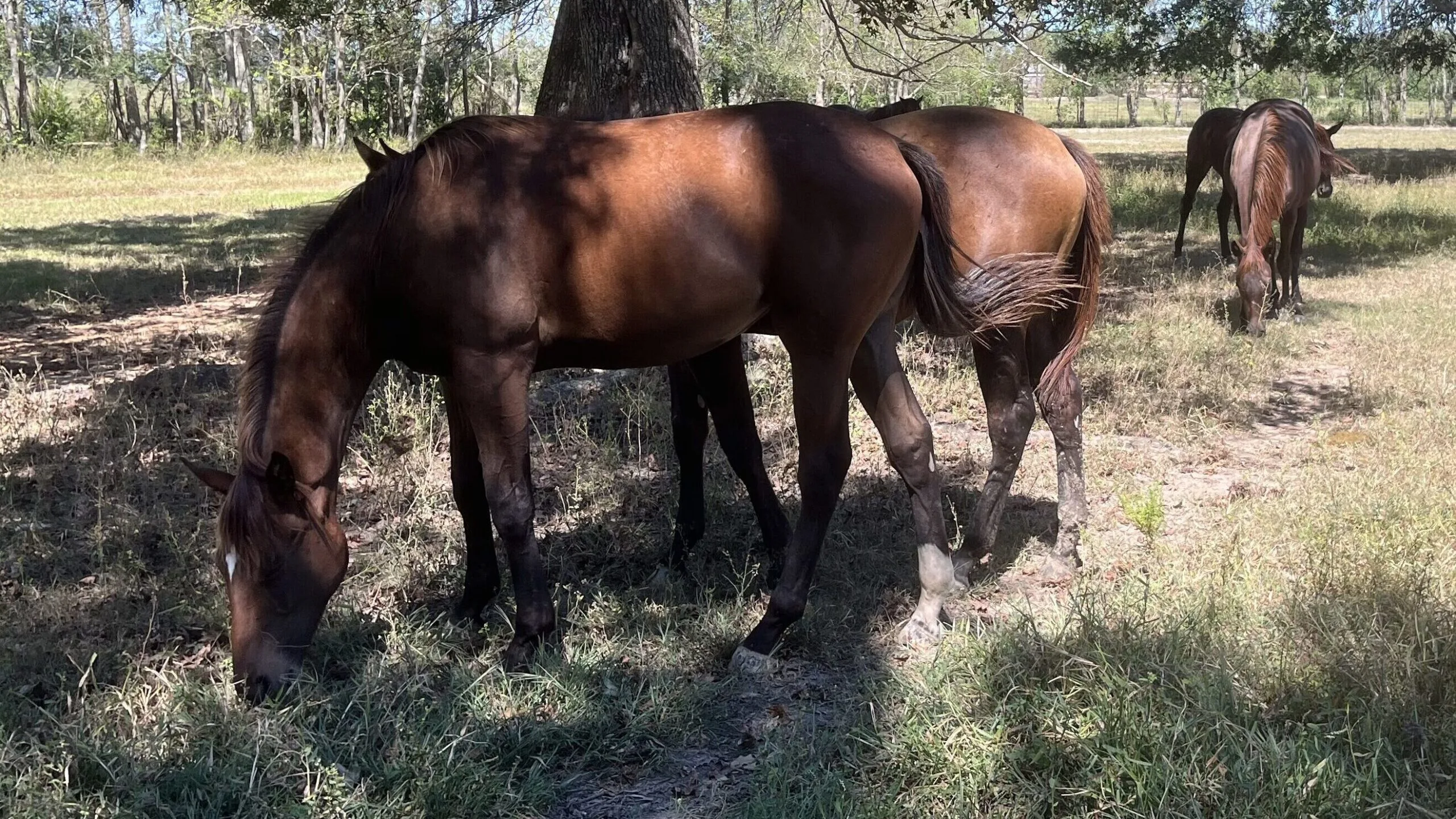
Best Age For Gelding a Horse?
Gelding horses is a nuanced decision, typically recommended between 6 months and 2 years of age. This timeframe is considered optimal for a few reasons:
- Age Range: Veterinarians often suggest the prime period for gelding is between 6-12 months. This window ensures the procedure is done when horses are resilient and can recover swiftly.
- Health Considerations: Before proceeding, it’s crucial to confirm the presence of both testicles in the scrotum. A missing testicle could indicate cryptorchidism, a condition requiring special attention.
- Behavioral and Physical Development: Gelding at a younger age leverages the horse’s natural resilience and is strategically timed to positively influence their behavior and physical growth.
This approach to gelding, grounded in veterinary expertise, balances health, behavior, and developmental outcomes, ensuring horses are well-prepared for their roles in equestrian activities.
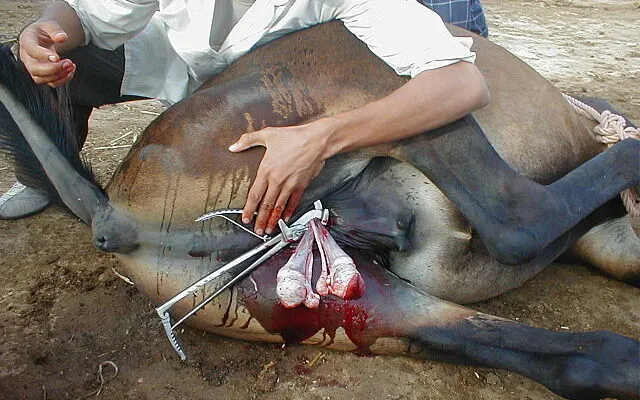
Castration procedure performed in a field. Source: L. Mahin, CC BY-SA 3.0
The Gelding Procedure Explained
Animal Welfare Focus: It’s important to note that gelding is performed not only to manage behavior and suitability for activities but also to enhance the horse’s overall welfare. This procedure, done under the care of experienced veterinarians, ensures the horse leads a comfortable and stress-free life.
- Before the Surgery:
- Health check and sedation
- Cleaning the area for surgery
- During the Surgery:
- Performed under anesthesia
- Removal of the testicles through small incisions
- Aftercare:
- Keeping the horse comfortable
- Monitoring for any signs of discomfort
- Ensuring cleanliness to prevent infection
Cryptorchidism in Horses
- Definition: Cryptorchidism in horses is a condition where one or both testicles do not descend into the scrotum. It’s a common issue in various horse breeds.
- Health Implications: This condition can lead to increased health risks, such as a higher likelihood of testicular tumors and certain behavioral issues due to retained testosterone production.
- Treatment: Cryptorchidism is typically addressed through surgical removal of the retained testicle(s), a procedure more complex than standard gelding.
- Relevance to Gelding: Understanding cryptorchidism is important in the context of gelding, as it affects the surgical approach and post-operative care. Horses with this condition may require specialized veterinary attention during gelding.
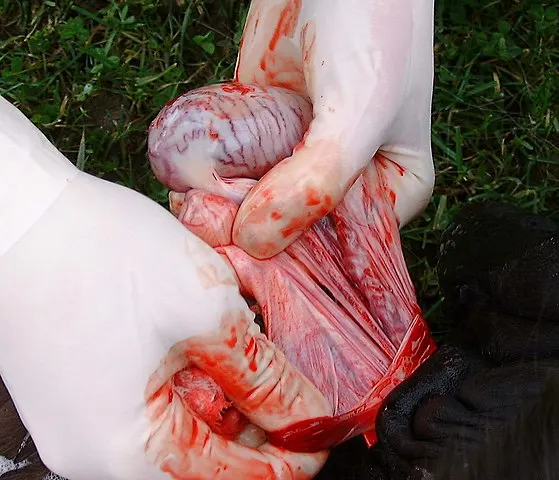
Horse testicles being removed. Source: Malcolm Morley, CC BY-SA 3.0
Myths vs. Facts About Gelding
- Myth: Gelding is painful and cruel.
- Fact: Performed under anesthesia to minimize discomfort.
- Myth: Gelding stunts a horse’s growth.
- Fact: No impact on growth; horses develop normally.
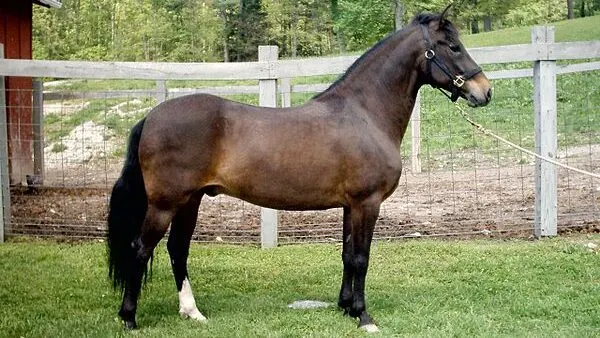
Paso Fino Gelding. Source: Soltera, CC BY-SA 3.0
The Impact of Gelding on Horses
Behavioral Changes:
- Temperament: Gelding typically results in a calmer, more manageable temperament.
- Social Interaction: Improved interactions with humans and other horses due to reduced aggression.
- Training and Adaptability: Enhanced focus and trainability, beneficial in various equestrian disciplines.
Health and Lifespan Benefits:
- Reduced Health Risks: Lower risk of testicular diseases and certain cancers.
- Stress Management: Decreased stress levels, contributing to overall well-being.
- Potential for Longer Lifespan: Healthier lifestyle choices and reduced risks can lead to a longer lifespan.
Advantages for Owners and Trainers:
- Easier Management: Simplified day-to-day handling and care.
- Versatility in Roles: Suitable for a wide range of activities, from leisure riding to competitive sports.
- Consistent Performance: More predictable behavior, aiding in training and performance.
Expert Insights:
- Veterinarian Advice: Recommendations on the best age and practices for gelding.
- Experienced Caretakers’ Tips: Insights into ongoing care and management post-gelding.
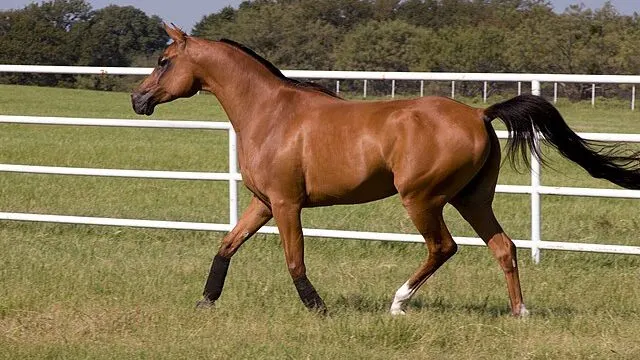
Arabian Gelding trotting. Source: Ealdgyth, CC BY 3.0
Comparison of a Gelding to a Stallion and Mare
- Gelding (Castrated Male Horse):
- Temperament: Generally calmer and more predictable than stallions due to reduced testosterone levels.
- Suitability: Preferred for recreational and competitive riding due to their even temperament.
- Management: Easier to manage and less prone to aggressive or dominant behaviors.
- Stallion (Intact Male Horse):
- Temperament: Can be more aggressive and dominant, influenced by higher testosterone levels.
- Suitability: Often used for breeding and may excel in competitive sports where strength and vigor are assets.
- Management: Requires experienced handling and often separate housing to prevent conflicts.
- Mare (Female Horse):
- Temperament: Can be more moody or sensitive, especially during estrous cycles.
- Suitability: Used in all equestrian disciplines; some riders prefer mares for their intelligence and sensitivity.
- Management: Generally easier than stallions but can have behavioral changes during heat cycles.
Video Insight: Unraveling the Personalities of Mares, Geldings, and Stallions
In this insightful YouTube video by Horse Class, a recognized authority in the equine industry examines the complex personalities and temperaments of horses.
The Role of Geldings in Equestrian Sports
Contribution in Equestrian Disciplines:
- Versatility: Geldings are known for their participation in a diverse array of disciplines, from dressage to show jumping.
- Steadiness: Their calm demeanor is highly valued in sports that require precision and consistency.
- Endurance and Eventing: Preferred for their stamina and even temperament, making them well-suited for challenging sports.
Famous Gelding Horses in History:
- Snowman: A remarkable story of a former plow horse who became a legendary show jumper.
- Red Rum: Known for his extraordinary achievement of winning the Grand National three times.
- Whispering Jack: An acclaimed dressage horse known for his grace and discipline in competition.
- Mine That Bird– won the Kentucky Derby, finished second in the Preakness, and third in the Belmont Stakes. He made 18 career starts, earning $2,228,637.
Selection for Equestrian Activities:
- Temperament Matching: Geldings are often chosen for activities where a calm, reliable horse is essential.
- Physical Capabilities: Their selection is also based on suitability for the physical demands of specific sports.
- Training and Adaptability: Ideal for a variety of disciplines due to their cooperative nature and ease of training.
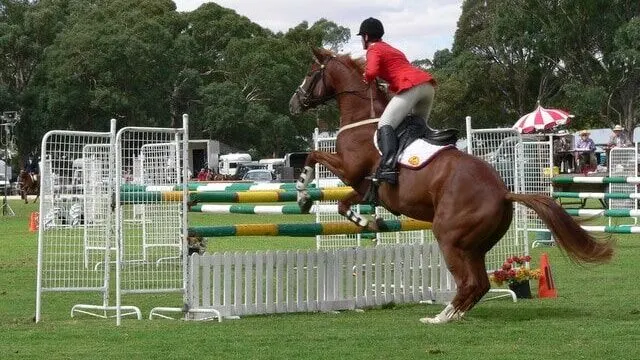
Myths and Misconceptions about Geldings
In the equestrian world, misconceptions about geldings are as prevalent as in any other aspect of horse care and management. Dispelling these myths is crucial for understanding and appreciating geldings for their true value.
Myth 1: Geldings Are Not as Athletic as Stallions
- Reality: Geldings can be just as athletic and talented as stallions. Their performance in various equestrian disciplines often matches or surpasses that of stallions, with athleticism depending more on individual capability and training.
Myth 2: Geldings Are Always Calm and Easy to Handle
- Reality: While geldings are generally more even-tempered than stallions, they are not automatically calm or easy to handle. Their temperament varies based on breed, personality, training, and upbringing.
Myth 3: Gelding a Horse Reduces Its Value
- Reality: The value of a horse is not solely determined by its breeding potential. Geldings are often highly valued for their performance, temperament, and suitability for various activities, and gelding can increase their value by making them more manageable.
Myth 4: Geldings Don’t Have Hormonal Behaviors
- Reality: Gelding significantly reduces, but does not entirely eliminate, hormonal behaviors. Some geldings may exhibit mild stallion-like behaviors, especially if gelded later in life.
Myth 5: Gelding Is a Cruel Procedure
- Reality: Gelding is a standard veterinary procedure performed under anesthesia to ensure the horse’s comfort. It’s done for health, behavior management, and suitability for roles, and is considered humane when performed by qualified veterinarians.
Myth 6: Geldings Are Only Good for Recreational Riding
- Reality: Geldings excel in various equestrian sports, including show jumping, dressage, eventing, and racing. Many top-performing sport horses are geldings, valued for their focus, consistency, and athleticism.
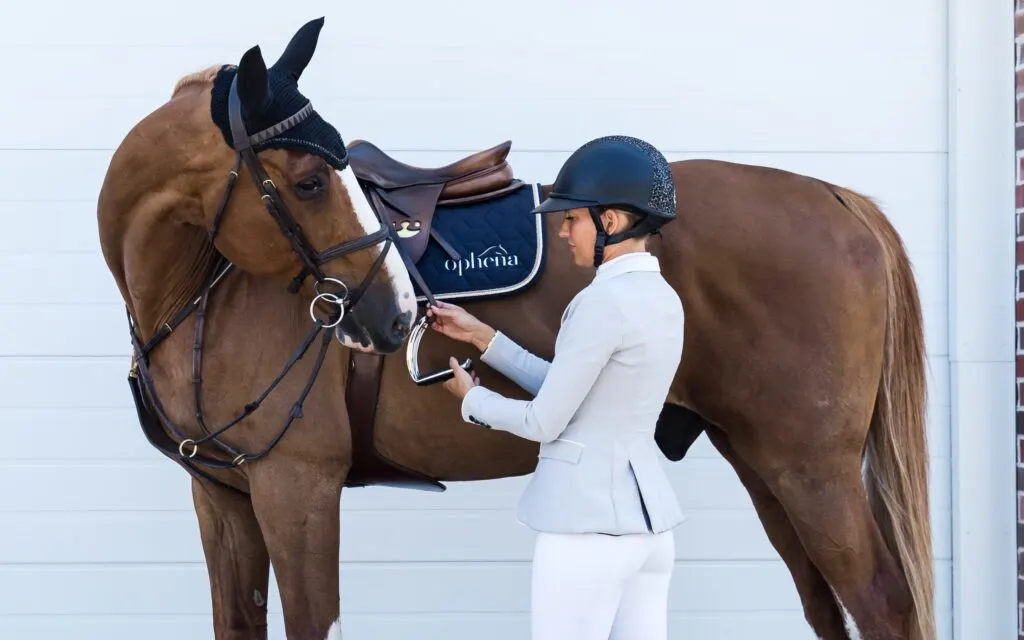
Why Do Racehorse Trainers Advise Gelding a Horse?
Focusing on racehorses, gelding is a common practice for several compelling reasons. Geldings are known for their focus and manageability, which are crucial attributes in the high-stakes world of horse racing.
Advantages of Gelding Racehorses
- Improved Focus and Trainability: Geldings tend to be more focused and easier to manage, responding better to training and jockey cues. This can lead to enhanced performance on the racetrack.
- Physical Benefits: The procedure reduces hormone production, which can cause muscle and joint stiffness. As a result, geldings often exhibit increased flexibility and agility, essential traits in racing.
- Health Benefits: Gelding eliminates risks associated with the reproductive system, such as testicular cancer, contributing to the horse’s overall health.
Considerations in Racehorse Training
- Breeding Potential: The decision to geld is carefully considered, especially for potential champion stallions. Intact males can sire foals and pass on desirable traits.
- Case by Case Basis: Each horse is evaluated individually. For instance, this year, we have two promising colts in training showing no stud behavior, allowing us to avoid castration for now.
Gelding racehorses is a strategic decision made by trainers to enhance performance, health, and manageability. While it eliminates breeding potential, the benefits in racing contexts often outweigh this factor.

FAQs: What is a gelding?
How many geldings have won the Kentucky Derby?
Only six geldings have won the Kentucky Derby; however, there have been 108 geldings qualified to run in this prestigious race. Although geldings may not fare well in the Derby, they represent themselves well in most other races.
What can retired gelding racehorses do?
Geldings retired from racing can be trained in other equine activities. Thoroughbred geldings are often used in dressage and jumping. Quarterhorse geldings can be used as barrel horses, cutting horses, or trail-riding horses. Some former racing geldings are turned out to pasture to enjoy their life as a horse.
What is a proud cut horse?
A proud cut horse is one that has been incompletely castrated, where some testicular tissue remains, possibly leading to stallion-like behaviors.
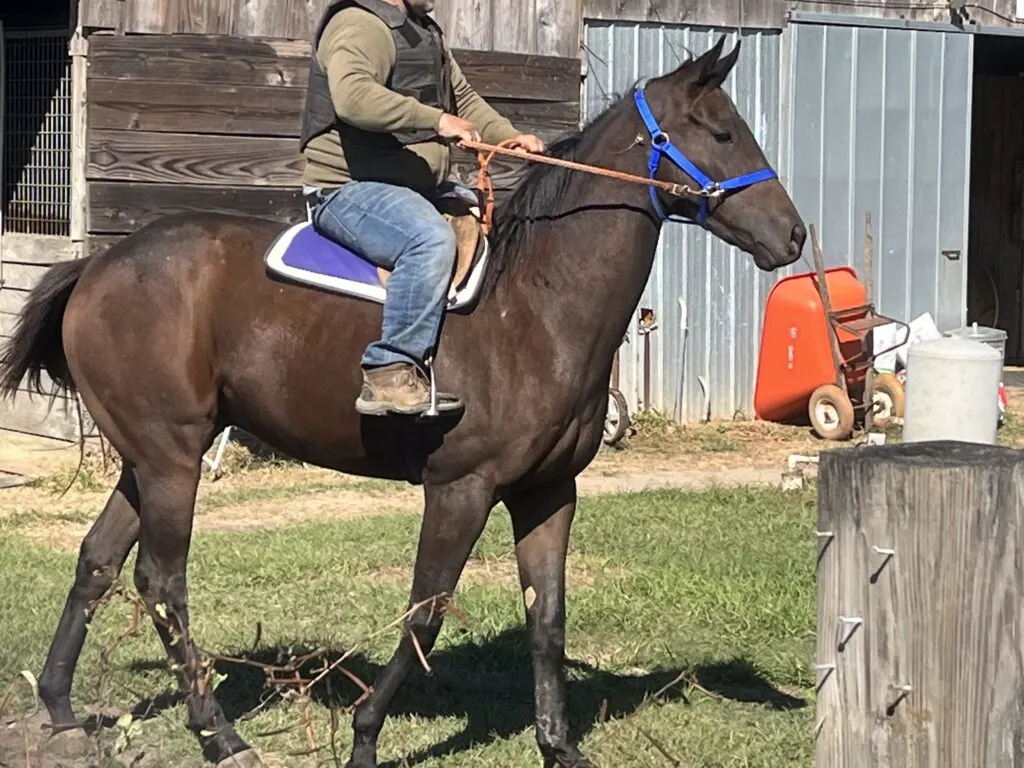
Conclusion
Gelding horses play a vital role in the equestrian world, offering benefits in behavior, health, and suitability for various activities. The process of gelding, typically performed at a young age, leads to a calmer and more manageable horse, ideal for both recreational and competitive settings.
Proper care, including balanced nutrition, regular exercise, and consistent veterinary check-ups, is essential for the well-being of gelding horses. As horse owners and caretakers, understanding and implementing these practices is key to ensuring the health and happiness of these magnificent animals. We encourage all horse enthusiasts to embrace responsible and informed horse ownership and care.
Authoritative References
To further enrich your understanding of geldings and related equestrian topics, here are some authoritative references that provide additional insights and information:
- American Association of Equine Practitioners (AAEP) – Gelding Care:
- Gelding Your Horse: Care and Considerations
- This resource from AAEP offers detailed information on the care and management of gelded horses, emphasizing the importance of veterinary guidance.
- The Horse – Comprehensive Horse Health:
- Gelding Health and Management
- The Horse magazine provides a collection of articles and studies on various aspects of gelding health, behavior, and management.
- Journal of Equine Veterinary Science – Research on Geldings:
- Effects of Castration on Horse Behavior and Physiology
- This scientific study offers insights into how gelding affects horses’ behavior and physiology, providing a research-based perspective.
- British Horse Society – Horse Welfare and Care:
- Understanding Gelding Procedures and Aftercare
- The British Horse Society offers comprehensive advice on horse welfare, including sections on gelding procedures and aftercare.
- Equine Science Center – Rutgers University:
- Equine Behavior and Management
- Rutgers University’s Equine Science Center provides fact sheets and articles on equine behavior and management, with relevant information for gelding owners.
- International Society for Equitation Science (ISES):
- Equine Behavior and Welfare
- ISES offers resources and publications on equine behavior and welfare, which can be useful for understanding the broader implications of gelding.
These references are from reputable organizations and publications in the field of equine health and management. They offer valuable information for anyone looking to deepen their understanding of geldings and their care.
Stay Connected and Informed:
- If you found this guide helpful, consider signing up for our newsletter for more insights and updates on horses.
- For personalized advice or specific inquiries, feel free to contact me directly. I’m here to help guide you through your horse learning journey.
Connect with Me
- Email: [email protected]
- Social Media: Follow me on Facebook for daily updates, tips, and insights into the world of horses.
- Website: Visit my website horseracingsense.com, for more articles, resources, and information about my work.
Join the Conversation:
- I encourage you to share your thoughts, experiences, or questions in the comments section below. Let’s create a community of informed and passionate horse lovers.
- Don’t forget to share this article with your network. Use the social share buttons to spread knowledge and love for horses.
Thank you for reading, and I look forward to connecting with you, whether it’s through our newsletter, direct communication, or in the comments section. Here’s to the thrilling journey of racehorse ownership!
